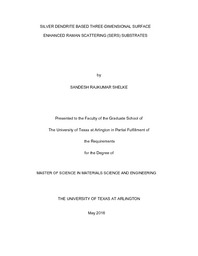
ATTENTION: The works hosted here are being migrated to a new repository that will consolidate resources, improve discoverability, and better show UTA's research impact on the global community. We will update authors as the migration progresses. Please see MavMatrix for more information.
Show simple item record
| dc.contributor.advisor | Hao, Yaowu | |
| dc.creator | Shelke, Sandesh Rajkumar | |
| dc.date.accessioned | 2016-07-22T17:53:19Z | |
| dc.date.available | 2016-07-22T17:53:19Z | |
| dc.date.created | 2016-05 | |
| dc.date.issued | 2016-06-01 | |
| dc.date.submitted | May 2016 | |
| dc.identifier.uri | http://hdl.handle.net/10106/25834 | |
| dc.description.abstract | Three-dimensional (3D) hierarchical nanostructures have been considered as one of the most promising surface-enhanced Raman spectroscopy (SERS) substrates because it provides high-density hotspots along the three-dimension directions and high surface areas.
In this thesis, we report the synthesis process to develop 3D SERS substrates in thin wall quartz capillary tube on Cu wire. These 3D SERS substrates consist of Ag dendrite, Au-Ag and Pd-Ag bimetallic nanostructures which was synthesized by employing simple galvanic replacement reactions (GRR). In this synthesis process Cu wire which is used as substrate was inserted in the thin walled quartz capillary tube and then AgNO3 was injected into the tube to form Ag dendrite on the Cu wire substrate. This pre-prepared dendrite was used to prepare bimetallic nanostructures of Au-Ag and Pd-Ag by injecting chlorauric acid (HAuCl4) and palladium chloride (PdCl4) into the tube, respectively. The GRR process leads to the replacement of Ag atoms by Au and Pd which causes corresponding morphological change of the underlying Ag dendrite. The GRR leaves pores where Ag is depleted. The morphological and compositional changes caused by GRR was analyzed by using scanning electron microscopy (SEM) and energy-dispersive X-ray spectroscopy (EDX). Two close metallic surfaces can enhance the electromagnetic (EM) field around molecules absorbed between them, which leads to extremely high SERS enhancement. These 3D SERS substrates was tested in detection of aqueous 4-Mercaptobenzoic Acid (4-MBA) solution with various concentrations. The fabricated substrate was employed to detect the 4-MBA solution to the detection limit down to 10-13 M and exhibits high- enhanced performance. The results indicated that these 3D unique bimetallic nanostructures can amplify Raman signals for extremely low concentration molecules as compared to the Ag dendrite nanostructure substrates. | |
| dc.format.mimetype | application/pdf | |
| dc.language.iso | en_US | |
| dc.subject | 3D SERS substrate | |
| dc.subject | SERS effect | |
| dc.subject | Ag dendrite | |
| dc.subject | Au-Ag bimetallic dendrite | |
| dc.subject | Pd-Ag bimetallic dendrite | |
| dc.title | SILVER DENDRITE BASED THREE-DIMENSIONAL SURFACE ENHANCED RAMAN SCATTERING (SERS) SUBSTRATES | |
| dc.type | Thesis | |
| dc.degree.department | Materials Science and Engineering | |
| dc.degree.name | Master of Science in Materials Science and Engineering | |
| dc.date.updated | 2016-07-22T17:53:50Z | |
| thesis.degree.department | Materials Science and Engineering | |
| thesis.degree.grantor | The University of Texas at Arlington | |
| thesis.degree.level | Masters | |
| thesis.degree.name | Master of Science in Materials Science and Engineering | |
| dc.type.material | text | |
| dc.creator.orcid | 0000-0003-1794-7770 | |
Files in this item
- Name:
- SHELKE-THESIS-2016.pdf
- Size:
- 3.229Mb
- Format:
- PDF
This item appears in the following Collection(s)
Show simple item record


